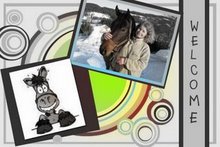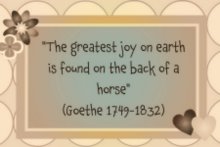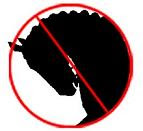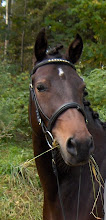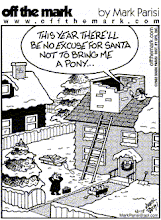
Stillearning wrote:
HOC, when you have time, could you also write a description of riding a horse straight, as in keeping equal weight in each rein, etc.?....I'm currently riding a "wiggle worm", so would enjoy your input.
So here comes a try.
First, I hope that she means the same as I do when it comes to a "wiggly" horse.
To me, it is a horse that pops out here and there.
Like when you are riding on a circle, the shoulder falls out. So you correct it, just to find that the horse then places the hindquarters to the inside instead. So you correct that etc, etc.
I think this problem, as well as the solution, differs a bit from the crooked horse (link to earlier post). So again I hope I have understood your question correct, stillearning?
First, I must say that my input here is just some personal comments from how I would have tried and solved the problem if I experienced it myself. I am not a professional trainer, and I do not know your horse or you as a rider, stillearning, so take it for what it's worth, ok?
And I am (as always) happy to get input/comments/questions from others!
Anyway, here are my 2 cents:
A wiggly horse is not easy to ride.
It is an evasive pattern in the horse, and I believe we'll have to go back to basics, as much of the problems we experience when riding is solved by looking at the base requests on the horse.
Many riders have heard of Steinbrecht's dictum
"Ride your horse forward and make him straight",
and I believe here lays the answer to this problem.
I would start by checking that my horse was really thinking forward.
I would make sure that he kept a clear rhythm and was in balance, but I would otherwise not worry too much about frame or collection. Sometimes this problem creeps up if the rider worries too much about frame and forgets that the horse always has to be in front of the leg.
So what to do?
I would want my horse to think forward as soon as I soften my hand, with the slightest touch of the leg. If he doesn't, I have to correct.
I would praise a lot when I get a reaction, and if I get more forward than I asked for, I would avoid putting on the brakes immediately as it will confuse my horse.
I would try and keep my horse relaxed, but attentive.
Exercises: Work much with transitions within the gait.
First, find a good working rhythm, and get your horse to relax and with a soft contact on the bit. Then, while keeping the rhythm try and soften your hands and get the horse to lengthen some strides. Don't ask too much in the beginning. Make sure he doesn't tense up and increase speed and rythm. Posting trot makes it easier, and helps you and the horse to think about the rythm. Help him with a tap on the hind quarters from a dressage whip if he doesn't understand. Praise immediately when your horse offers the right response.
Then through half halts, softly collect again for a few steps. When you collect, it might again be necessary to tap on the hindquarters to help your horse to understand that he needs to activate the hind legs, and not solve the equation by working with less energy.
Repeat.
And repeat.
For each time, find the working trot/canter in between and make your horse relax before you again start to ask for lengthening/shortening of the strides.
What you should be looking for is that the horse actively seeks contact on the rein.
Make sure that you have a true three-beat rythm in the canter, also when you collect. If you get a four-beat it is due to lack of impulsion - get some more energy into the work!
Keep the balance in corners and in changes of direction through half halts. Make sure that your tempo here is not larger than the horse can handle. If you feel loss of balance, collect more or make a transition downwards.
Then start to work with transitions between the gaits.
Concentrate on quality.
In the transistions upwards, remember that the movement has to start with engaged hindlegs, and not by pulling with the front end.
Concentrate on how it feels.
Does your horse respond quickly? Is he using the front or the rear engine most when getting started? Does your horse get heavy in the hand? Is he tensed or relaxed? Again, use a dressage whip if necessary to tap the hindquarters to help the horse understand what you want.
Downhill transitions:
Prepare, prepare is the key. Collect the horse first through half halts. Try and use the seat, and as little hand as possible. If you feel that the horse falls on the forehand and get heavy in the hands - correct it by not doing the transistion but to ride on again - like you have been doing when riding transitions within the gaits earlier. Ride the horse forward to get the hind legs working again. Then make a new attempt.
Try and keep the horse relaxed all through the work.
If he tenses up in the poll or jaw, he will not work correctly. I would then introduce some circles and flex to the inside, with an immediate release on the inside rein when he gives. I would make sure that when I ride my circles I have a soft, but steady contact in my outer rein. If I lose that contact, I would add more inside leg, to engage the inside hind and achieve bend in the body.
In the base of the German training scales lies
1. Rhythm
2. Relaxation and
3. Contact
All these three are important when we work with the wiggly horse.
We have to send the horse forward, to get a true contact - but while maintaining the rhythm and keeping the horse relaxed.
Remember that the hand has to be quiet, as the engagement comes from the hindlegs into the hand to create a correct contact.
The rider's seat also plays an important role here. To keep a quiet hand the rider needs an "independent seat", i.e. he should not be depending on rein contact to keep a good balance.
Did that help, stillearning?

Don't forget to praise and reward...and have fun!
 Back to work, both for the twolegged ones, and the fourlegged ones!
Back to work, both for the twolegged ones, and the fourlegged ones!












 It is by the Norwegian author Per Petterson, and is called
It is by the Norwegian author Per Petterson, and is called  Camilla Läckberg first.
Camilla Läckberg first.






